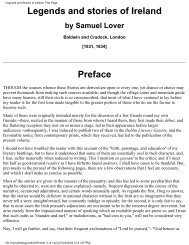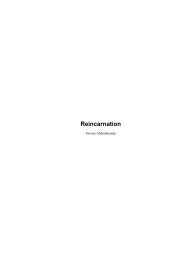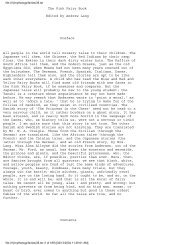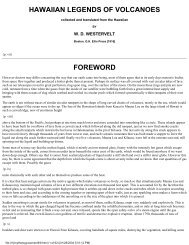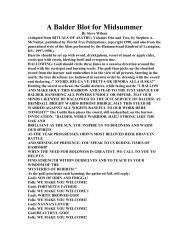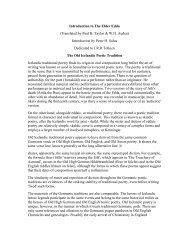You also want an ePaper? Increase the reach of your titles
YUMPU automatically turns print PDFs into web optimized ePapers that Google loves.
greco che in egiziano, sono altrettanti caratteri del tipo ieratico del periodo esclusivamente romano, a cui il nostro papiro<br />
appartiene senza alcun dubbio." Il Libro dei Funerali, p. 19. On Devéria's work in connection with this MS., see Maspero,<br />
Le Rituel du sacrifice Funéraire (in Revue de l'Histoire des Religions, t. xv., p. 161).]<br />
{p. x}<br />
II. The Theban version, which was commonly written on papyri in hieroglyphics and was divided into<br />
sections or chapters, each of which had its distinct title but no definite place in the series. The version<br />
was much used from the XVIIIth to the XXth dynasty.<br />
III. A version closely allied to the preceding version, which is found written on papyri in the hieratic<br />
character and also in hieroglyphics. In this version, which came into use about the XXth dynasty, the<br />
chapters have no fixed order.<br />
IV. The so-called Saïte version, in which, at some period anterior probably to the XXVIth dynasty, the<br />
chapters were arranged in a definite order. It is commonly written in hieroglyphics and in hieratic, and it<br />
was much used from the XXVIth dynasty to the end of the Ptolemaic period.<br />
Early forms of the Book of the Dead.<br />
The Book of the Dead.<br />
The earliest inscribed monuments and human remains found in Egypt prove that the ancient Egyptians<br />
took the utmost care to preserve the bodies of their<br />
{p. xi}<br />
dead by various processes of embalming. The deposit of the body in the tomb was accompanied by<br />
ceremonies of a symbolic nature, in the course of which certain compositions comprising prayers, short<br />
litanies, etc., having reference to the future life, were recited or chanted by priests and relatives on behalf<br />
of the dead. The greatest importance was attached to such compositions, in the belief that their recital<br />
would secure for the dead an unhindered passage to God in the next world, would enable him to<br />
overcome the opposition of all ghostly foes, would endow his body in the tomb with power to resist<br />
corruption, and would ensure him a new life in a glorified body in heaven. At a very remote period<br />
certain groups of sections or chapters had already become associated with some of the ceremonies which<br />
preceded actual burial, and these eventually became a distinct ritual with clearly defined limits. Side by<br />
side, however, with this ritual there seems to have existed another and larger work, which was divided<br />
into an indefinite number of sections or chapters comprising chiefly prayers, and which dealt on a larger<br />
scale with the welfare of the departed in the next world, and described the state of existence therein and<br />
the dangers which must be passed successfully before it could be reached, and was founded generally on<br />
the religious dogmas and mythology of the Egyptians. The title of "Book of the Dead" is usually given by<br />
Egyptologists to the editions of the larger work which were made in the XVIIIth and following dynasties,<br />
but in this Introduction the term is intended to include the general body of texts which have reference to<br />
the burial of the dead and to the new life in the world beyond the grave, and which are known to have<br />
existed in revised editions and to have been in use among the Egyptians from about B.C. 4500, to the<br />
early centuries of the Christian era.<br />
Uncertainty of the history of its source<br />
The home, origin, and early history of the collection of ancient religious texts which have descended to<br />
us are, at present, unknown, and all working theories regarding them, however strongly supported by<br />
file:///I|/mythology/egypt/1/1.html (4 of 189) [01/25/2004 3:29:57 PM]



